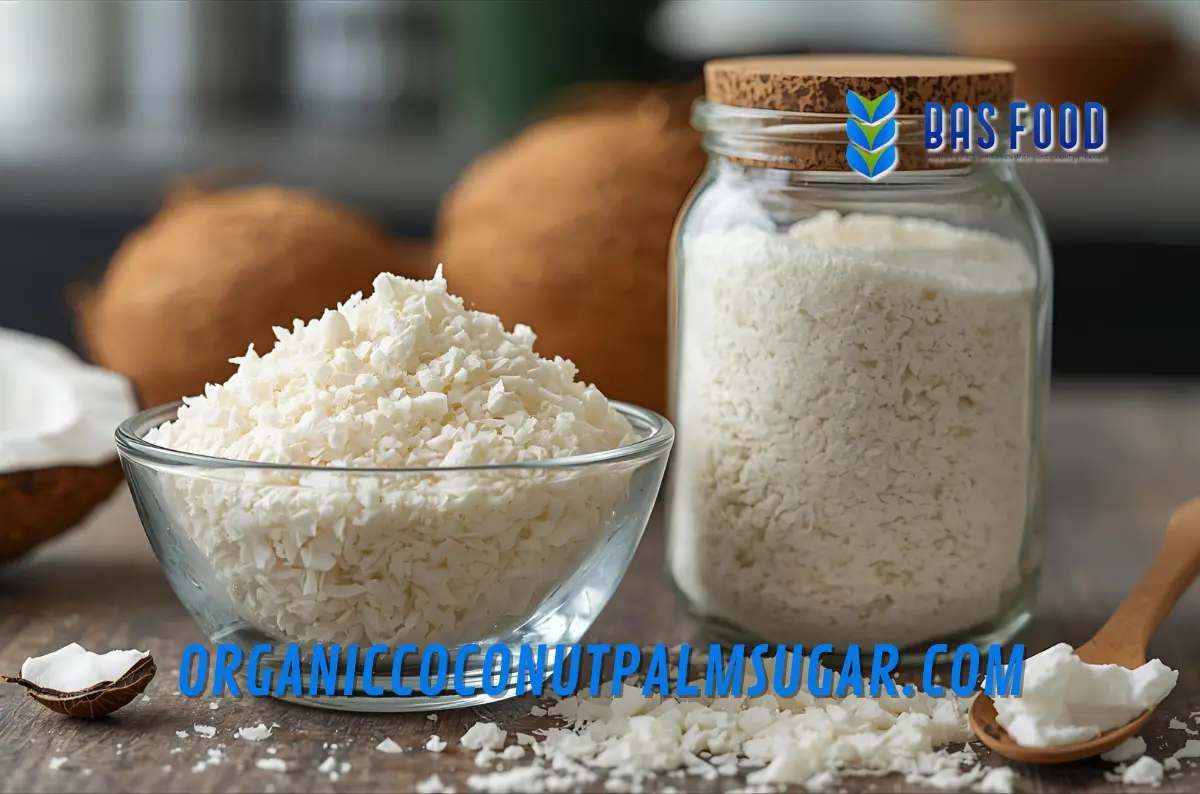In modern baking, coconut-based ingredients have carved a niche among health-conscious and gluten-free enthusiasts. When considering desiccated coconut vs coconut flour, you find two of the most talked-about options. At first glance, they might look similar—both are derived from the same fruit and share a mild sweetness. However, their texture, nutritional content, and culinary roles tell a very different story.
This article explores the fascinating comparison of desiccated coconut vs coconut flour, helping bakers, chefs, and home cooks understand when to use which. We’ll also touch on their coconut ingredients comparison, gluten-free alternatives, and coconut nutrition value—all while introducing CV Bonafide Anugerah Sentosa, a trusted Indonesian supplier of coconut products, spices, and fishery commodities.

What Exactly Is Desiccated Coconut?
Desiccated coconut refers to finely shredded, dried white coconut meat with minimal moisture content. It’s a staple in bakeries and confectioneries worldwide for its mild aroma and natural sweetness. Unlike coconut flakes, desiccated coconut is finer and more uniform, giving baked products an even texture and consistent flavor.
The process involves removing the brown shell, washing the white meat, shredding it, and drying it to a specific moisture level—usually below 3%. This ensures long shelf life without added preservatives. Depending on preference, desiccated coconut is available in high-fat or low-fat variants, with the former giving richer flavor and moisture to baked products.
As a natural product, it’s often used in cookies, energy bars, and fillings, adding chewiness and aroma that elevate recipes without overpowering other ingredients.
Understanding Coconut Flour and Its Rise in Gluten-Free Baking
Coconut flour, on the other hand, is made from dried coconut meat that has been defatted after extracting coconut milk. What’s left is a fine, powder-like substance—light, absorbent, and high in fiber. It has become a favorite gluten-free alternative to wheat flour, especially among those on paleo, keto, or low-carb diets.
The most notable quality of coconut flour is its high absorbency. Just a small amount can soak up large quantities of liquid, which makes recipe adjustments crucial. When baking with coconut flour, one usually adds more eggs or liquid to maintain moisture.
Its mild flavor complements both sweet and savory dishes. From muffins to pancakes and even bread, coconut flour offers versatility while providing a boost of coconut nutrition—particularly in dietary fiber and medium-chain triglycerides (MCTs).
Texture and Taste: Key Differences in Baking Results
When comparing desiccated coconut vs coconut flour, one of the biggest distinctions lies in texture. Desiccated coconut retains a slight chewiness and grainy texture. It doesn’t dissolve into batters but adds body and bite, making it ideal for toppings, coatings, and inclusions in desserts.
Coconut flour, however, behaves more like traditional flour—it thickens batters and absorbs moisture quickly. It gives a softer crumb structure but lacks the fibrous bite of desiccated coconut.
Taste-wise, both share the signature coconut aroma, but desiccated coconut has a richer and more natural sweetness due to its higher fat content. Coconut flour’s flavor is lighter and less pronounced, which works well in recipes where coconut shouldn’t dominate the flavor profile.
Nutritional Comparison: Which One Is Healthier?
From a nutritional standpoint, both products offer unique advantages. Desiccated coconut is higher in healthy fats, particularly MCTs, which are quickly converted into energy by the body. It’s also a decent source of minerals like manganese and copper, which support metabolism and bone health.
Coconut flour, on the other hand, is a champion of dietary fiber. A small serving can deliver more fiber than many grain-based flours, helping regulate digestion and blood sugar levels. Its lower fat and carbohydrate content make it ideal for those managing weight or blood glucose.
Here’s a simple coconut ingredients comparison (per 100g average):
| Nutrient | Desiccated Coconut | Coconut Flour |
|---|---|---|
| Calories | 650 kcal | 420 kcal |
| Fat | 60 g | 12 g |
| Protein | 6 g | 18 g |
| Fiber | 7 g | 40 g |
| Carbohydrates | 24 g | 25 g |
The takeaway? Desiccated coconut delivers richer taste and texture, while coconut flour offers superior fiber and lower fat content—each catering to different health and culinary goals.
Culinary Uses: When to Use Each in Baking
In the world of baking and desserts, desiccated coconut shines as a texture enhancer rather than a primary flour substitute. It works beautifully in cakes, macaroons, granola bars, and truffles. Its fibrous nature gives crunch and aroma without altering the batter’s consistency too much.
Coconut flour, conversely, is best used as part of a flour blend. On its own, it can make baked goods too dense or dry. Mixing it with almond flour or other gluten-free flours creates balance and better rise. It’s excellent for recipes like brownies, pancakes, muffins, and cookies that require a soft crumb.
In confectionery applications, desiccated coconut provides a visual and textural delight—used as a coating on chocolates, doughnuts, and pastries. Meanwhile, coconut flour finds its niche in health-focused recipes designed for gluten-intolerant or diabetic consumers.
Coconut Nutrition and Dietary Benefits
Both desiccated coconut and coconut flour offer notable coconut dietary benefits. They’re gluten-free, grain-free, and naturally rich in beneficial fats and minerals. MCTs in coconuts support metabolism and may assist in weight management.
Coconut flour’s impressive fiber content promotes satiety, helping control appetite and digestion. Its low glycemic index makes it suitable for people managing diabetes or carbohydrate intake.
Desiccated coconut’s fat content, though higher, consists mainly of lauric acid—known for its antimicrobial and immune-boosting properties. Regular but moderate consumption contributes to heart health and sustained energy levels.
Global Market and Supply Chain: Indonesia’s Role
Indonesia plays a key role in the global coconut industry, including desiccated coconut and coconut flour production. With its tropical climate and vast coconut plantations, the country provides a consistent supply of high-quality, organic coconut-based ingredients for food manufacturers worldwide.
CV Bonafide Anugerah Sentosa, one of Indonesia’s leading exporters, has become a trusted name in the industry. The company supplies coconut products, spices, coffee, and fishery commodities to global partners. With modern facilities and sustainable sourcing practices, Bonafide ensures every shipment meets international food safety and quality standards.
Their product range includes organic desiccated coconut, high-fat and low-fat variants, and premium coconut sugar, all processed under strict hygiene and certification guidelines.
Environmental and Economic Impacts of Coconut Processing
Beyond the kitchen, the coconut industry also contributes significantly to local economies. Farmers and processors in regions like Sulawesi, North Sumatra, and Java depend on coconuts for their livelihood. The industry promotes sustainable agricultural practices, especially when producing organic variants.
Sustainability efforts include minimizing waste by using coconut husks for charcoal, shells for activated carbon, and coir for ropes and mats. As global demand for gluten-free alternatives grows, coconut-based products continue to offer both environmental and economic value to producing countries.
Choosing the Right Coconut Ingredient for Your Business
Whether you’re a home baker or a large-scale manufacturer, the choice between desiccated coconut vs coconut flour depends on your product goals. If you want natural sweetness, chewiness, and flavor depth—desiccated coconut is unbeatable. For healthier, high-fiber baked goods or gluten-free innovation, coconut flour takes the crown.
Working with a reliable supplier like CV Bonafide Anugerah Sentosa ensures consistent quality, competitive pricing, and compliance with international food standards. Their expertise in coconut sourcing and processing makes them a go-to partner for global buyers looking for authentic Indonesian coconut products.
Conclusion: Two Coconut Stars, One Delicious Future
Both desiccated coconut and coconut flour deserve a place in modern kitchens. Each brings unique benefits—one adds texture and taste, the other offers health and fiber. Together, they showcase the versatility and richness of coconut, one of nature’s most complete ingredients.
As global food trends lean toward sustainability and nutrition, these coconut derivatives are set to remain essential in the evolving landscape of baking and food production.
Contact CV Bonafide Anugerah Sentosa how we can provide the best solutions for you. WhatsApp: +62 8213 4505 737, Email: info@bonafideanugerahsentosa.com / bas.mdir@gmail.com.

